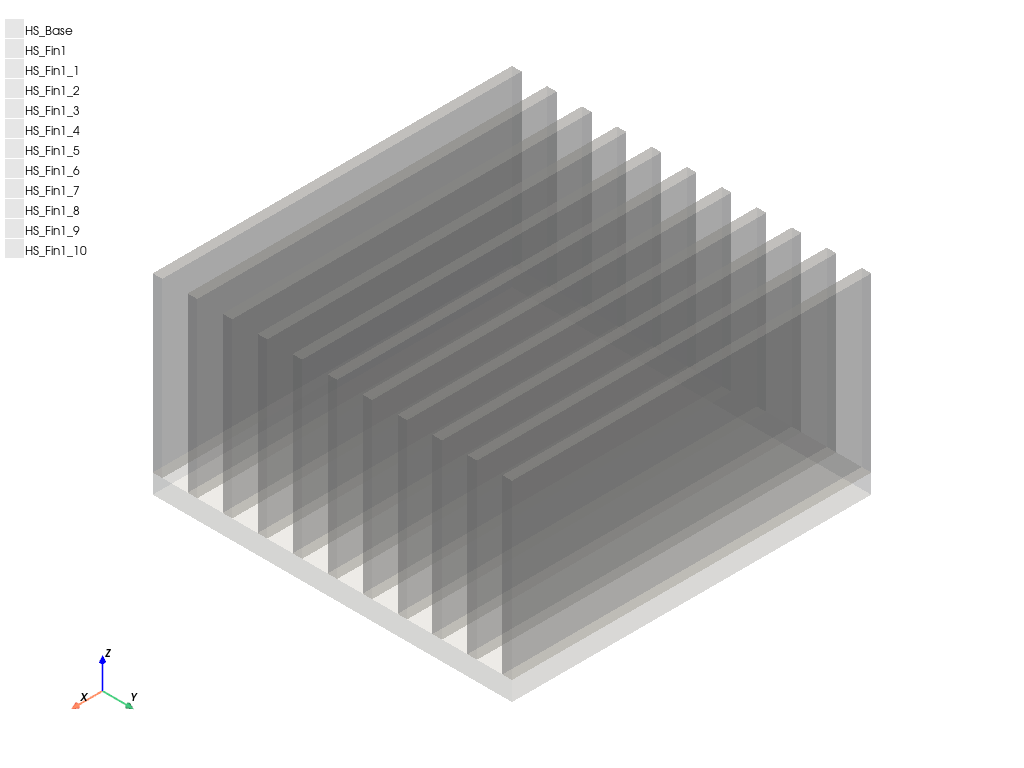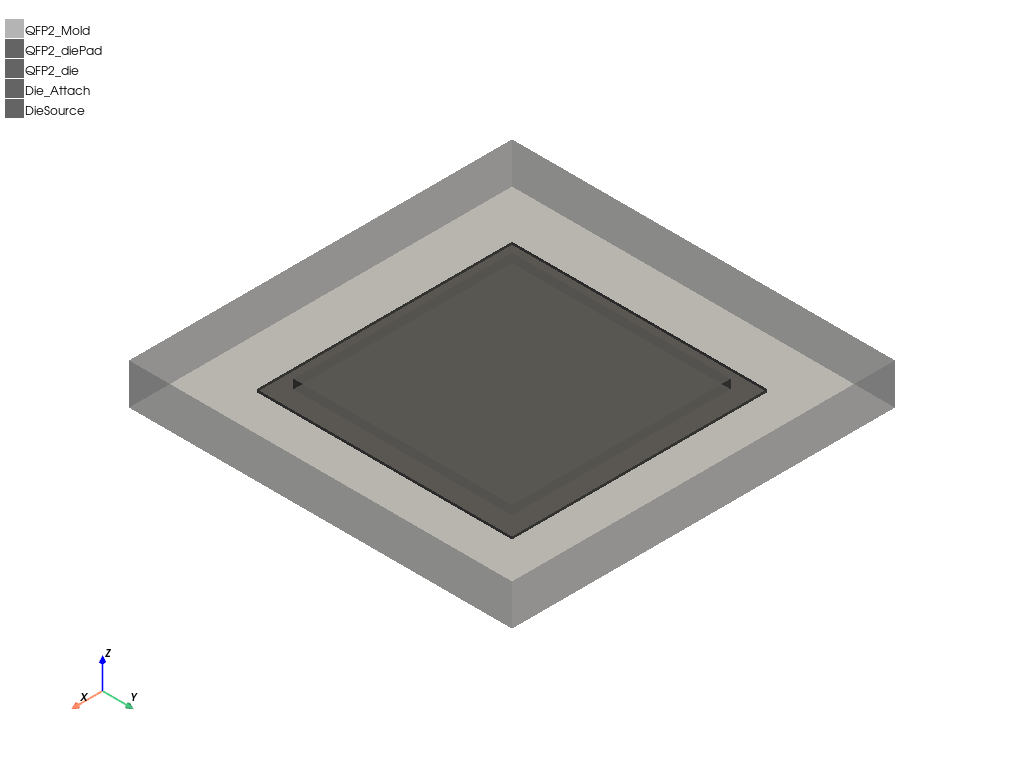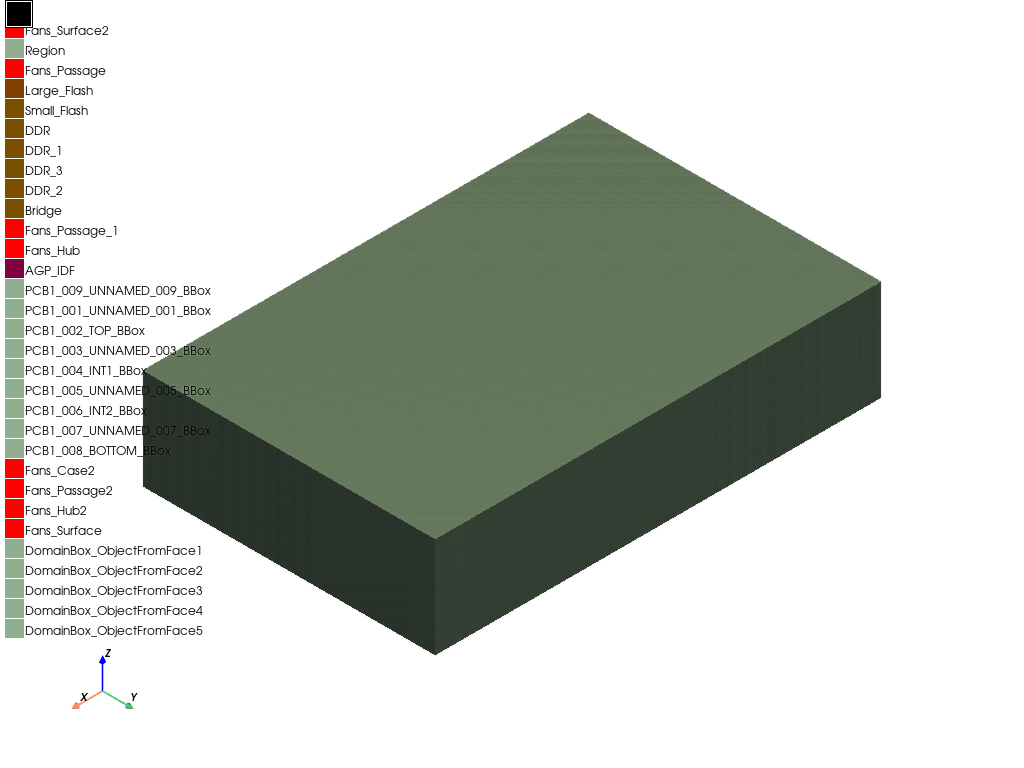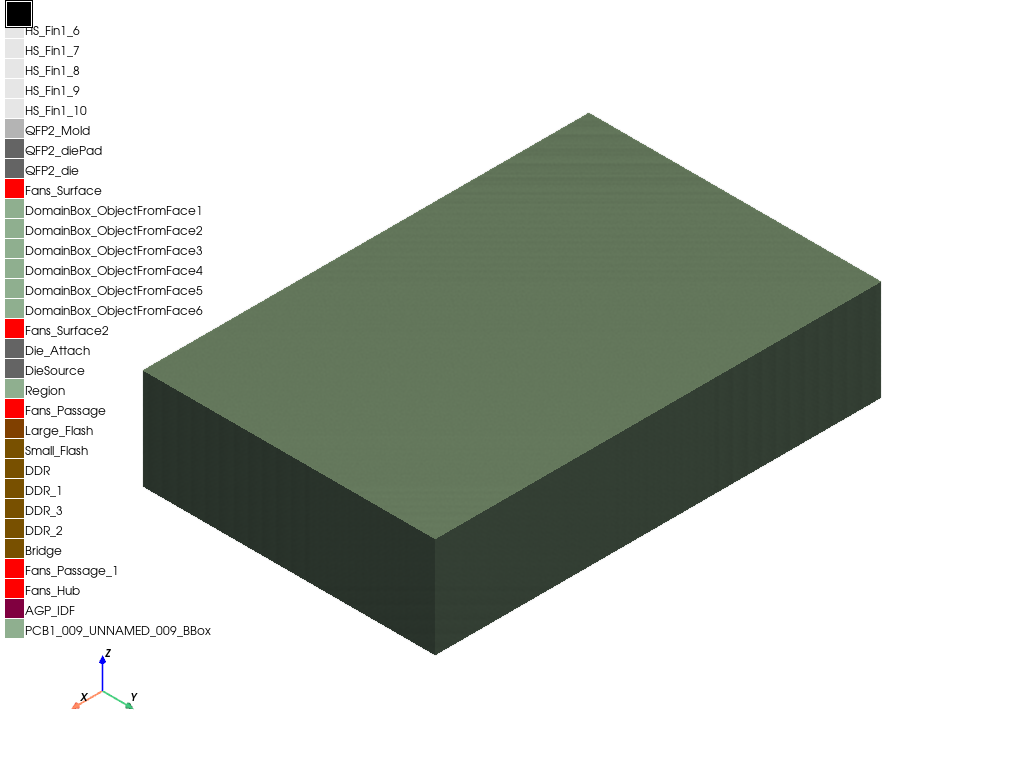Note
Go to the end to download the full example code.
Icepak: thermal analysis with 3D components#
This example shows how to create a thermal analysis of an electronic package by taking advantage of 3D components and features added by PyAEDT.
Import PyAEDT and download files#
Perform import of required classes from the pyaedt package and import the os package.
from pyaedt import Icepak, generate_unique_folder_name, downloads, settings
import os
# Download needed files
temp_folder = generate_unique_folder_name()
package_temp_name, qfp_temp_name = downloads.download_icepak_3d_component(temp_folder)
Set AEDT version#
Set AEDT version.
aedt_version = "2024.1"
Set non-graphical mode#
Set non-graphical mode.
You can set non_graphical either to True or False.
non_graphical = False
Create heatsink#
Open a new project in non-graphical mode.
ipk = Icepak(project=os.path.join(temp_folder, "Heatsink.aedt"),
version=aedt_version,
non_graphical=non_graphical,
close_on_exit=True,
new_desktop=True)
# Remove air region created by default because it is not needed as the heatsink will be exported as a 3DComponent.
ipk.modeler.get_object_from_name("Region").delete()
# Definition of heatsink with boxes
hs_base = ipk.modeler.create_box(origin=[0, 0, 0], sizes=[37.5, 37.5, 2], name="HS_Base")
hs_base.material_name = "Al-Extruded"
hs_fin = ipk.modeler.create_box(origin=[0, 0, 2], sizes=[37.5, 1, 18], name="HS_Fin1")
hs_fin.material_name = "Al-Extruded"
hs_fin.duplicate_along_line([0, 3.65, 0], nclones=11)
ipk.plot(show=False, output_file=os.path.join(temp_folder, "Heatsink.jpg"))
# Definition of a mesh region. First a non-model box is created, then the mesh region is assigned
mesh_box = ipk.modeler.create_box(origin=[-2, -2, -3], sizes=[41.5, 41.5, 24])
mesh_box.model = False
mesh_region = ipk.mesh.assign_mesh_region([mesh_box.name])
mesh_region.UserSpecifiedSettings = True
mesh_region.MaxElementSizeX = "5mm"
mesh_region.MaxElementSizeY = "5mm"
mesh_region.MaxElementSizeZ = "1mm"
mesh_region.MinElementsInGap = "4"
mesh_region.MaxLevels = "2"
mesh_region.BufferLayers = "1"
mesh_region.update()
# Assignment of monitor objects.
hs_fin5_object = ipk.modeler.get_object_from_name("HS_Fin1_5")
point_monitor_position = [0.5 * (hs_base.bounding_box[i] + hs_base.bounding_box[i + 3]) for i in range(2)] + [
hs_fin5_object.bounding_box[-1]] # average x,y, top z
ipk.monitor.assign_point_monitor(point_monitor_position, monitor_quantity=["Temperature", "HeatFlux"],
monitor_name="TopPoint")
ipk.monitor.assign_face_monitor(hs_base.bottom_face_z.id, monitor_quantity="Temperature", monitor_name="Bottom")
ipk.monitor.assign_point_monitor_in_object("HS_Fin1_5", monitor_quantity="Temperature", monitor_name="Fin5Center")
# Export the heatsink 3D component and close project. auxiliary_dict is set to true in order to export the
# monitor objects along with the .a3dcomp file.
os.mkdir(os.path.join(temp_folder, "componentLibrary"))
ipk.modeler.create_3dcomponent(os.path.join(temp_folder, "componentLibrary", "Heatsink.a3dcomp"), name="Heatsink",
export_auxiliary=True)
ipk.close_project(save=False)

C:\actions-runner\_work\_tool\Python\3.10.9\x64\lib\subprocess.py:1072: ResourceWarning: subprocess 6308 is still running
_warn("subprocess %s is still running" % self.pid,
C:\actions-runner\_work\pyaedt\pyaedt\.venv\lib\site-packages\pyaedt\generic\settings.py:428: ResourceWarning: unclosed file <_io.TextIOWrapper name='D:\\Temp\\pyaedt_ansys.log' mode='a' encoding='cp1252'>
self._logger = val
True
Create QFP#
Download and open a project containing a QPF.
ipk = Icepak(project=qfp_temp_name)
ipk.plot(show=False, output_file=os.path.join(temp_folder, "QFP2.jpg"))
# Create dataset for power dissipation.
x_datalist = [45, 53, 60, 70]
y_datalist = [0.5, 3, 6, 9]
ipk.create_dataset("PowerDissipationDataset", x_datalist, y_datalist, z=None, v=None, is_project_dataset=False,
x_unit="cel", y_unit="W", v_unit="")
# Assign source power condition to the die.
ipk.create_source_power(
"DieSource",
thermal_dependent_dataset="PowerDissipationDataset",
source_name="DieSource"
)
# Assign thickness to the die attach surface.
ipk.create_conduting_plate(face_id="Die_Attach",
thermal_specification="Thickness",
shell_conduction=True,
thickness="0.05mm",
solid_material="Epoxy Resin-Typical",
bc_name="Die_Attach",
)
# Assign monitor objects.
ipk.monitor.assign_point_monitor_in_object("QFP2_die", monitor_quantity="Temperature", monitor_name="DieCenter")
ipk.monitor.assign_surface_monitor("Die_Attach", monitor_quantity="Temperature", monitor_name="DieAttach")
# Export the QFP 3D component and close project. Here the auxiliary dictionary allows exporting not only the monitor
# objects but also the dataset used for the power source assignment.
ipk.modeler.create_3dcomponent(os.path.join(temp_folder, "componentLibrary", "QFP.a3dcomp"), name="QFP",
export_auxiliary=True, datasets=["PowerDissipationDataset"])
ipk.release_desktop(False, False)

C:\actions-runner\_work\pyaedt\pyaedt\.venv\lib\site-packages\pyaedt\icepak.py:628: DeprecationWarning: This method is deprecated in 0.7.8. Use the ``assign_conducting_plate()`` method.
warnings.warn(
True
Create electronic package#
Download and open a project containing the electronic package.
ipk = Icepak(project=package_temp_name,
version=aedt_version,
non_graphical=non_graphical)
ipk.plot(show=False, output_file=os.path.join(temp_folder, "electronic_package_missing_obj.jpg"))
# The heatsink and the QFP are missing. They can be inserted as 3d components. The auxiliary files are needed since
# the aim is to import also monitor objects and datasets. Also, a coordinate system is created for the heatsink so
# that it is placed on top of the AGP.
agp = ipk.modeler.get_object_from_name("AGP_IDF")
cs = ipk.modeler.create_coordinate_system(
origin=[agp.bounding_box[0], agp.bounding_box[1], agp.bounding_box[-1]],
name="HeatsinkCS",
reference_cs="Global",
x_pointing=[1, 0, 0],
y_pointing=[0, 1, 0],
)
heatsink_obj = ipk.modeler.insert_3d_component(
input_file=os.path.join(temp_folder, "componentLibrary", "Heatsink.a3dcomp"), coordinate_system="HeatsinkCS",
auxiliary_parameters=True)
QFP2_obj = ipk.modeler.insert_3d_component(input_file=os.path.join(temp_folder, "componentLibrary", "QFP.a3dcomp"),
coordinate_system="Global", auxiliary_parameters=True)
ipk.plot(show=False, output_file=os.path.join(temp_folder, "electronic_package.jpg"))
# Create a coordinate system at the xmin, ymin, zmin of the model
bounding_box = ipk.modeler.get_model_bounding_box()
cs_pcb_assembly = ipk.modeler.create_coordinate_system(
origin=[bounding_box[0], bounding_box[1], bounding_box[2]],
name="PCB_Assembly",
reference_cs="Global",
x_pointing=[1, 0, 0],
y_pointing=[0, 1, 0],
)
# Export of the whole assembly as 3d component and close project. First, a flattening is needed because nested 3d
# components are not natively supported. Then it is possible to export the whole package as 3d component. Here the
# auxiliary dictionary is needed to export monitor objects, datasets and native components.
ipk.flatten_3d_components()
ipk.modeler.create_3dcomponent(input_file=os.path.join(temp_folder, "componentLibrary", "PCBAssembly.a3dcomp"),
name="PCBAssembly", coordinate_systems=["Global", "HeatsinkCS", "PCB_Assembly"],
reference_coordinate_systems="PCB_Assembly", export_auxiliary=True)
C:\actions-runner\_work\_tool\Python\3.10.9\x64\lib\subprocess.py:1072: ResourceWarning: subprocess 6196 is still running
_warn("subprocess %s is still running" % self.pid,
C:\actions-runner\_work\pyaedt\pyaedt\.venv\lib\site-packages\pyaedt\modeler\cad\Primitives3D.py:1486: ResourceWarning: unclosed file <_io.TextIOWrapper name='D:\\Temp\\pyaedt_prj_Q48\\componentLibrary\\Heatsink.a3dcomp.json' mode='r' encoding='cp1252'>
aux_dict = json.load(open(auxiliary_parameters, "r"))
C:\actions-runner\_work\pyaedt\pyaedt\.venv\lib\site-packages\pyaedt\modeler\cad\Primitives3D.py:1486: ResourceWarning: unclosed file <_io.TextIOWrapper name='D:\\Temp\\pyaedt_prj_Q48\\componentLibrary\\QFP.a3dcomp.json' mode='r' encoding='cp1252'>
aux_dict = json.load(open(auxiliary_parameters, "r"))
True
Release AEDT#
Release AEDT.
ipk.release_desktop(True, True)
True
Total running time of the script: (1 minutes 54.019 seconds)

